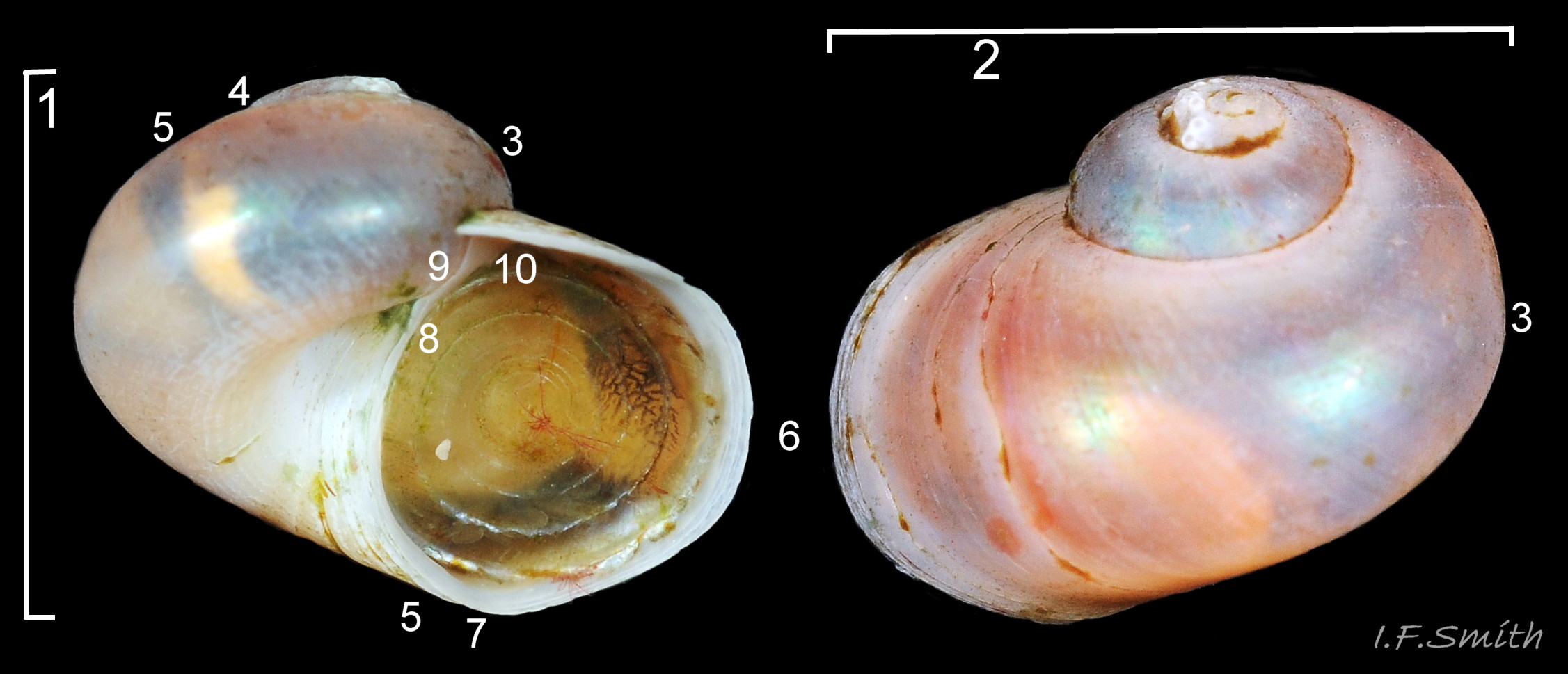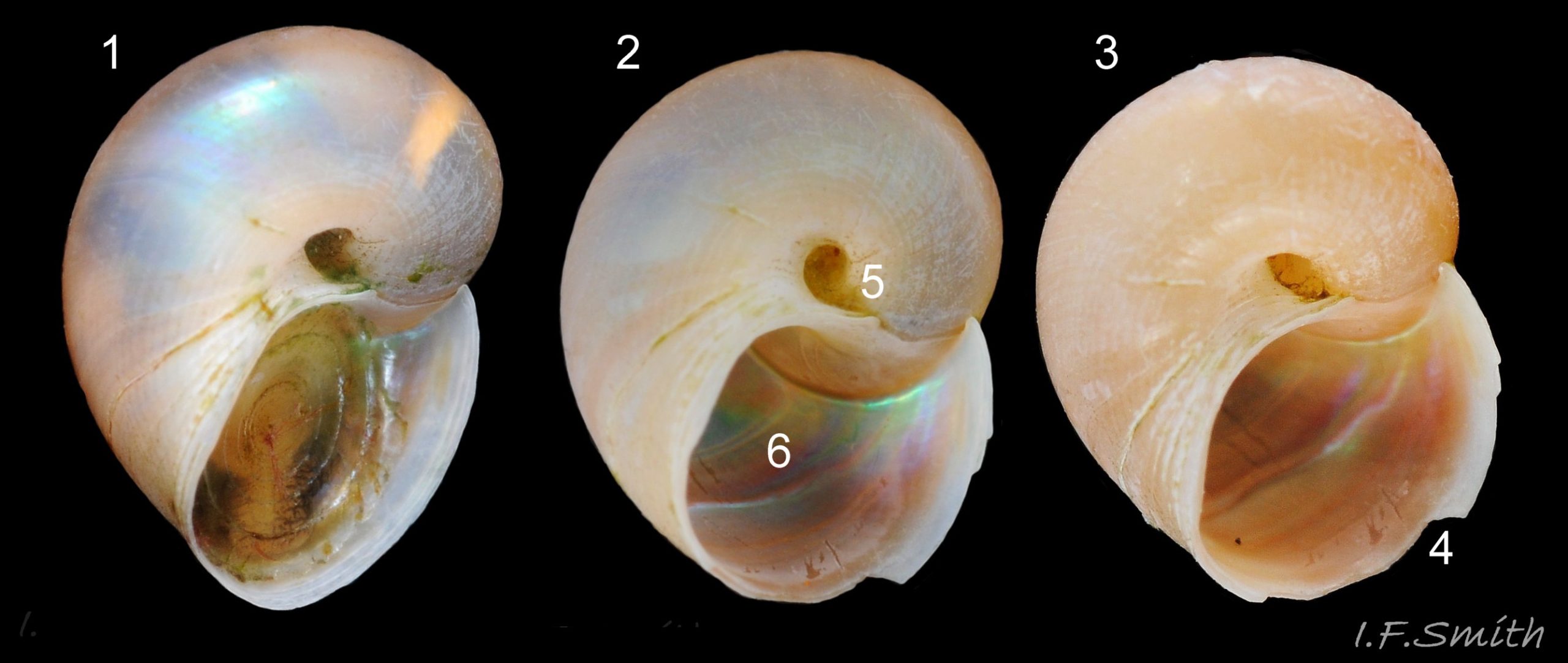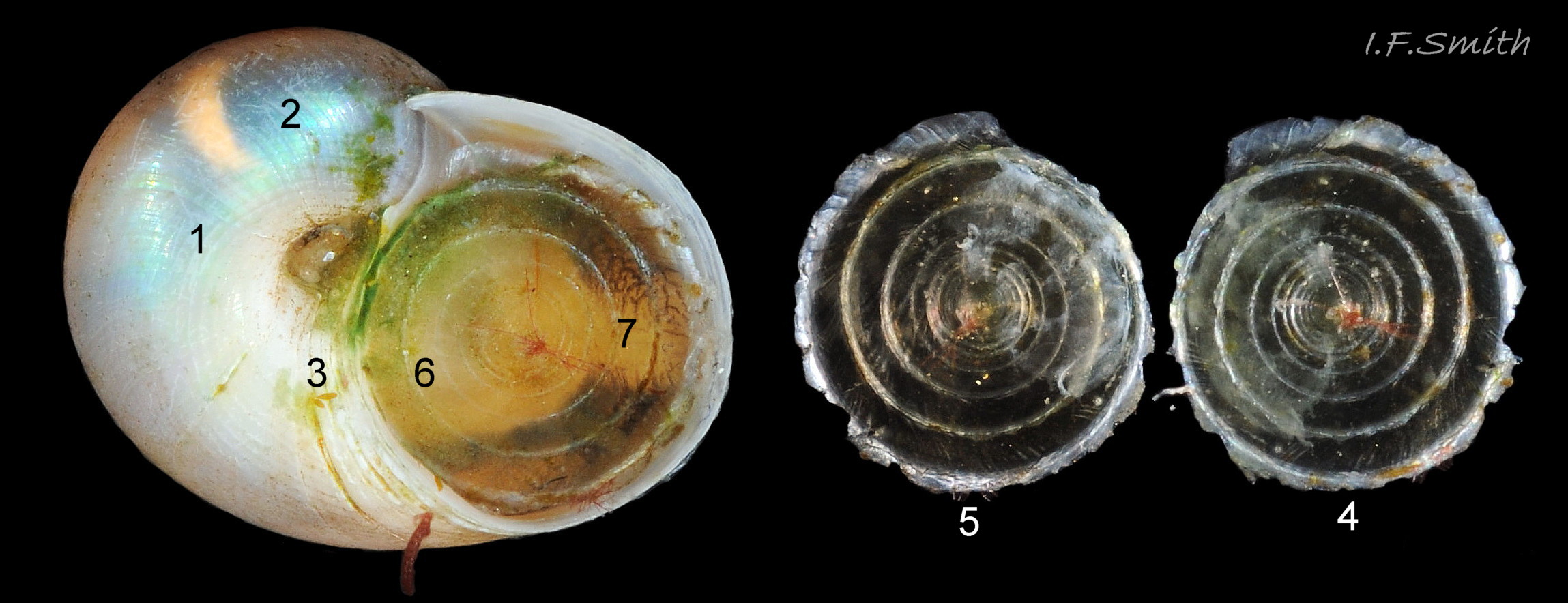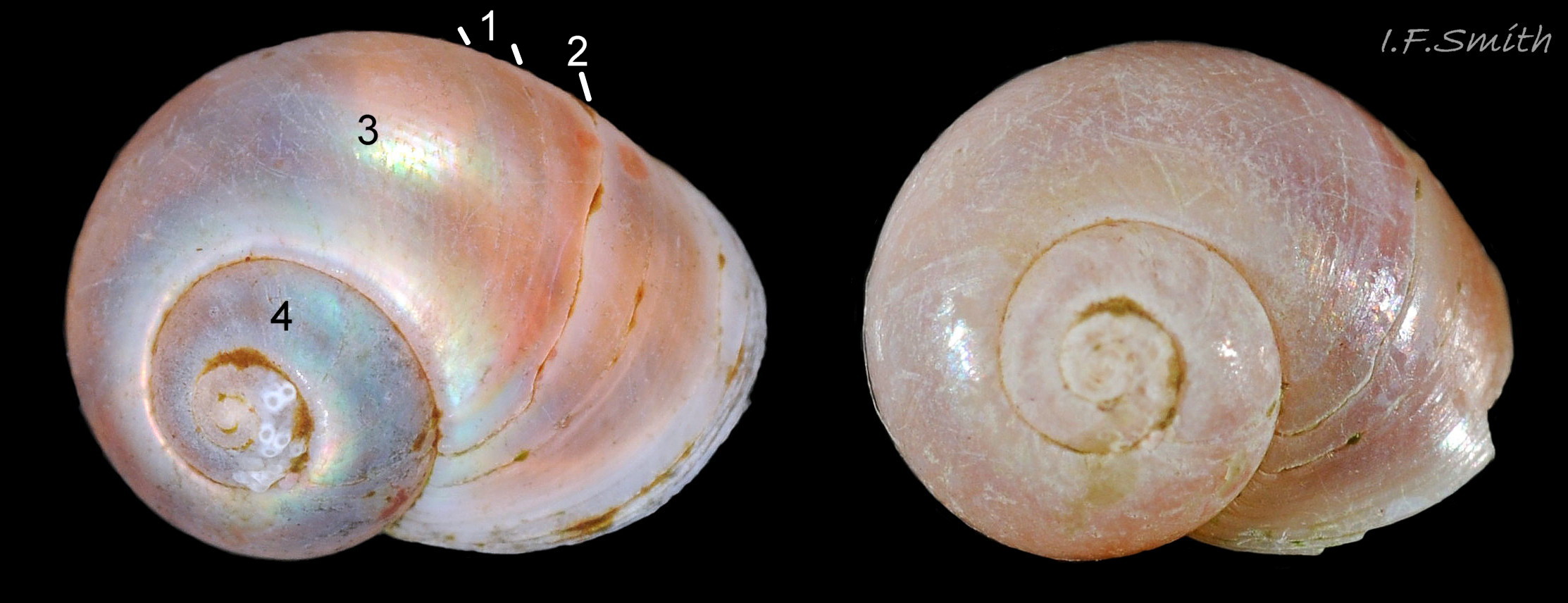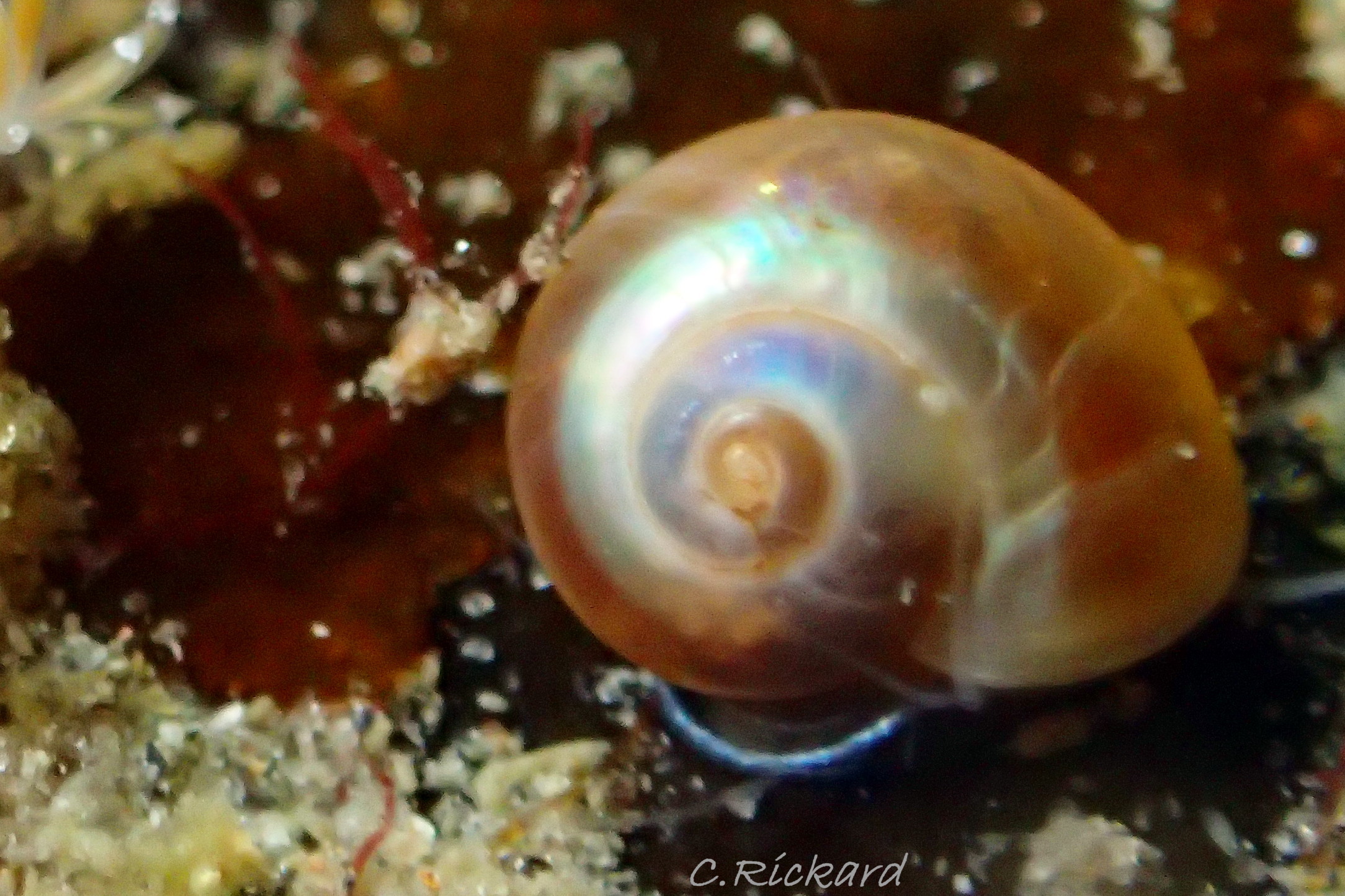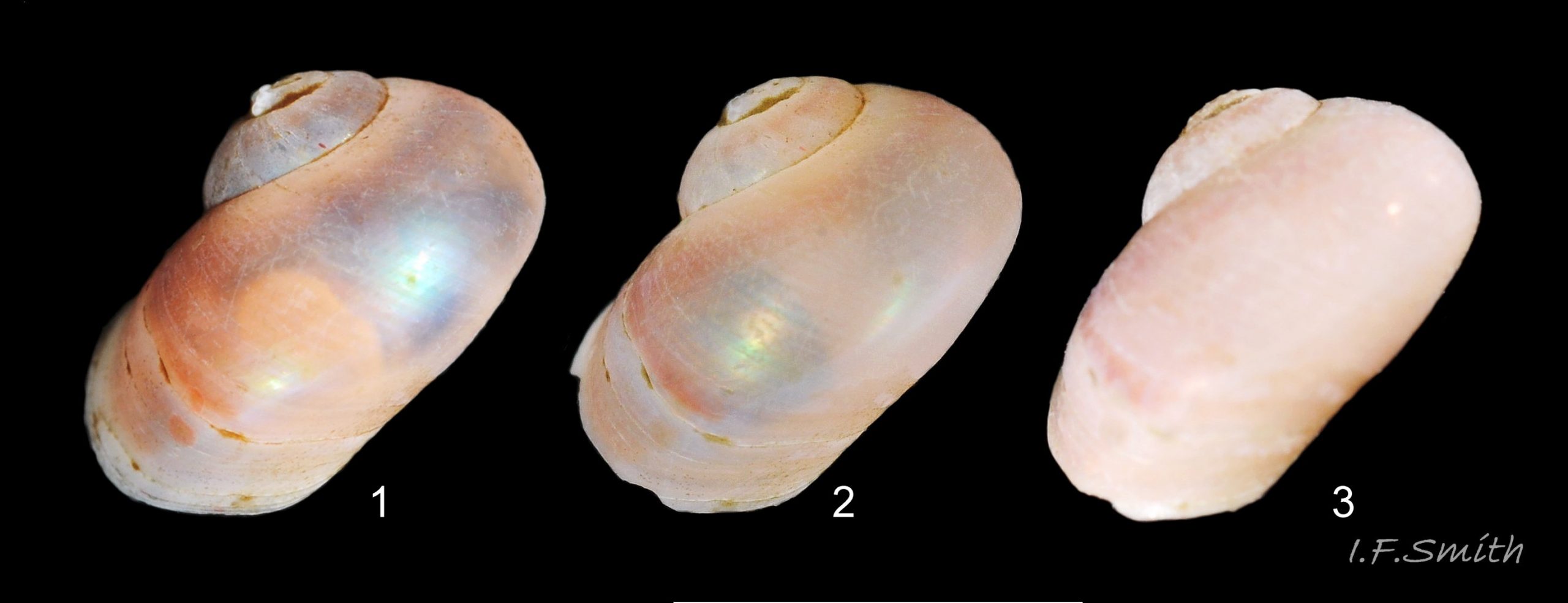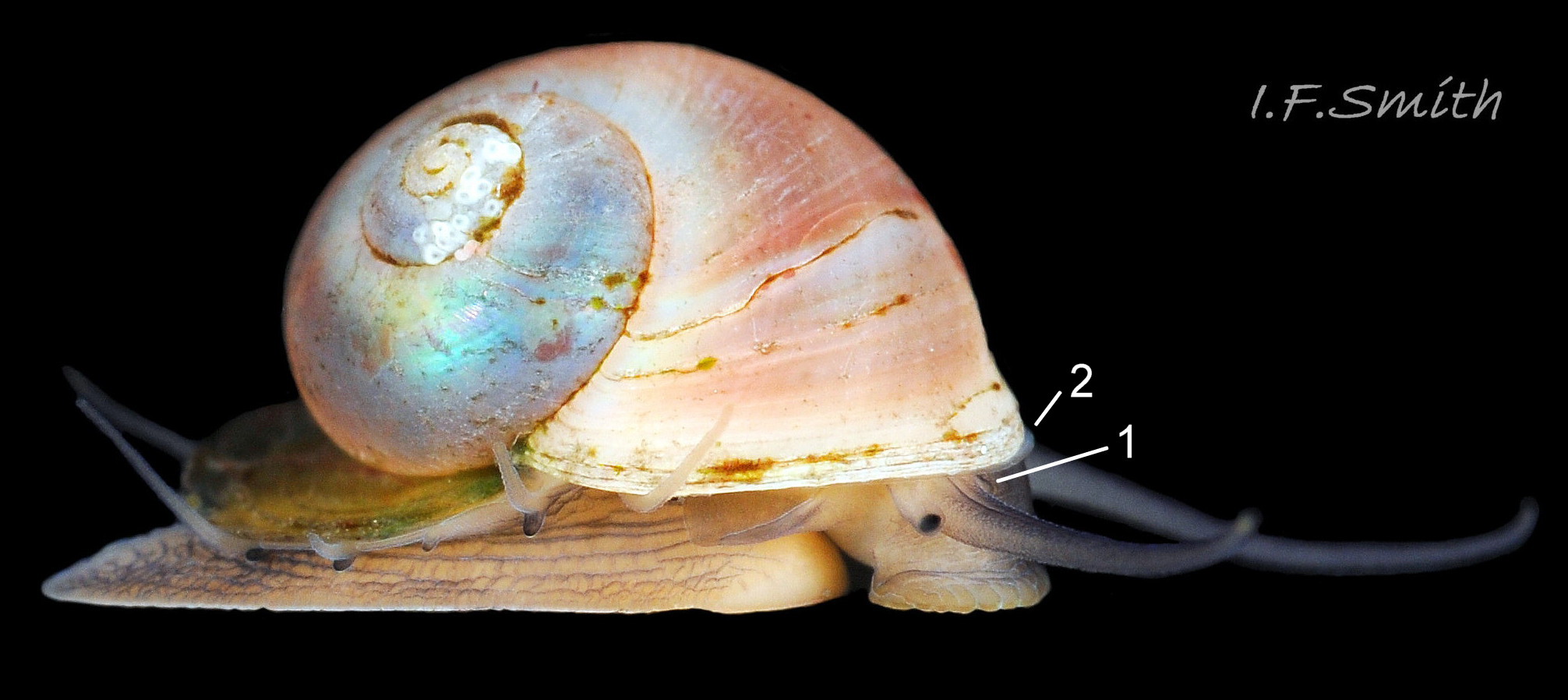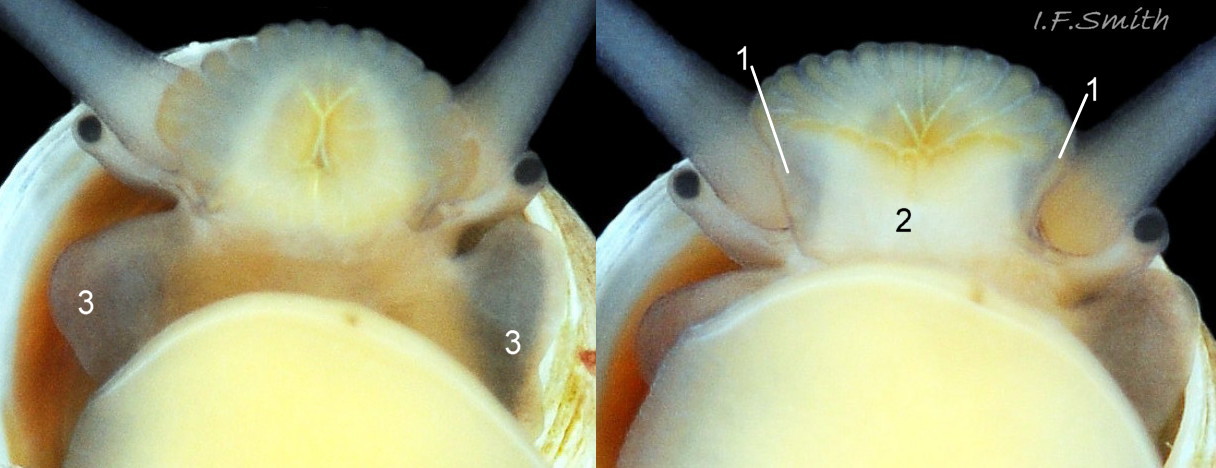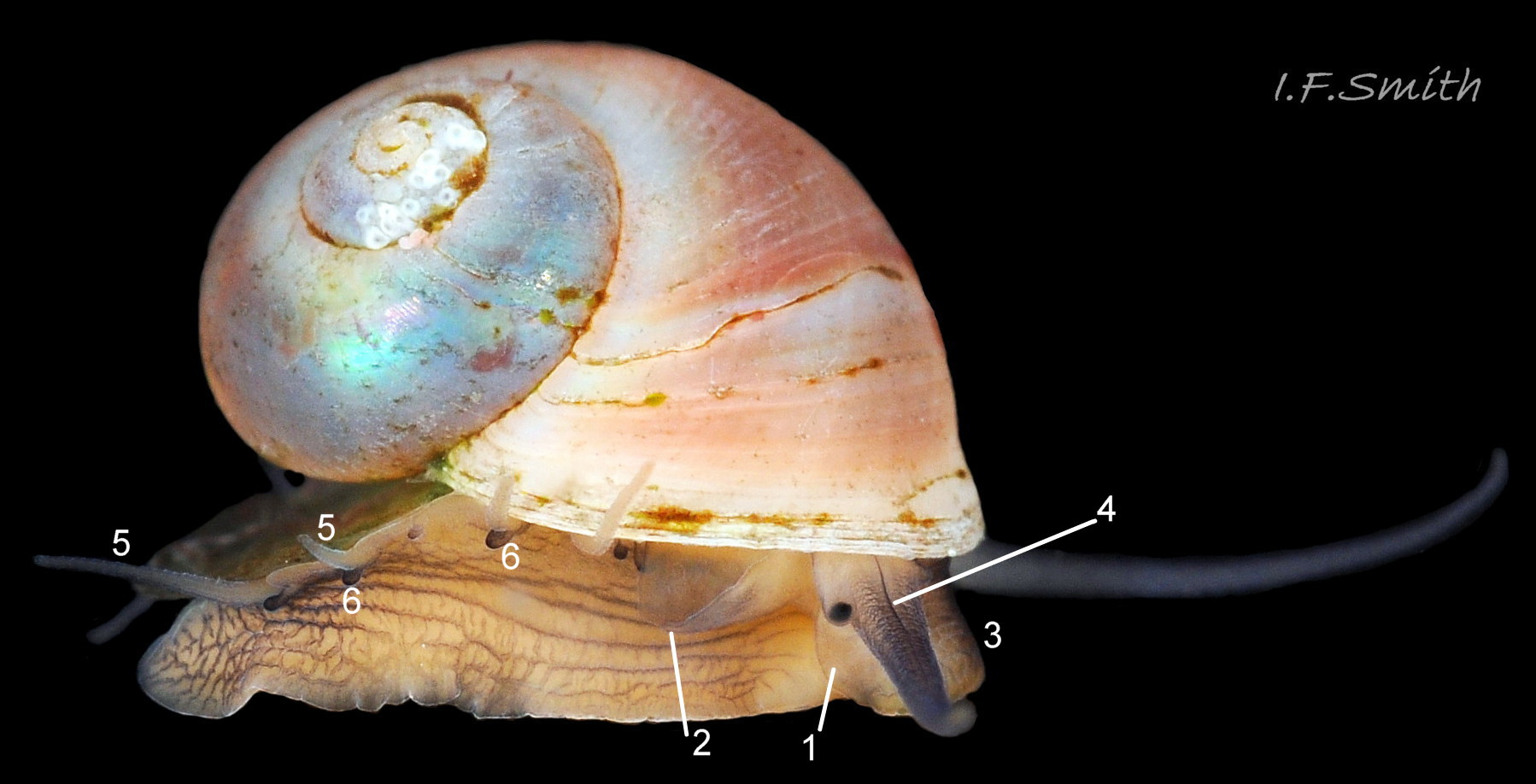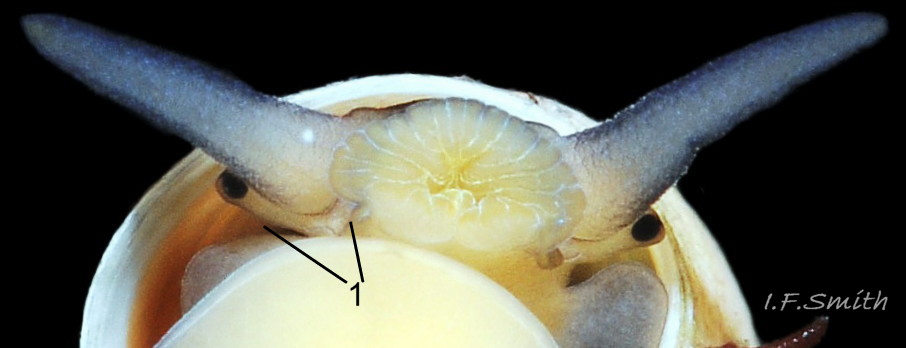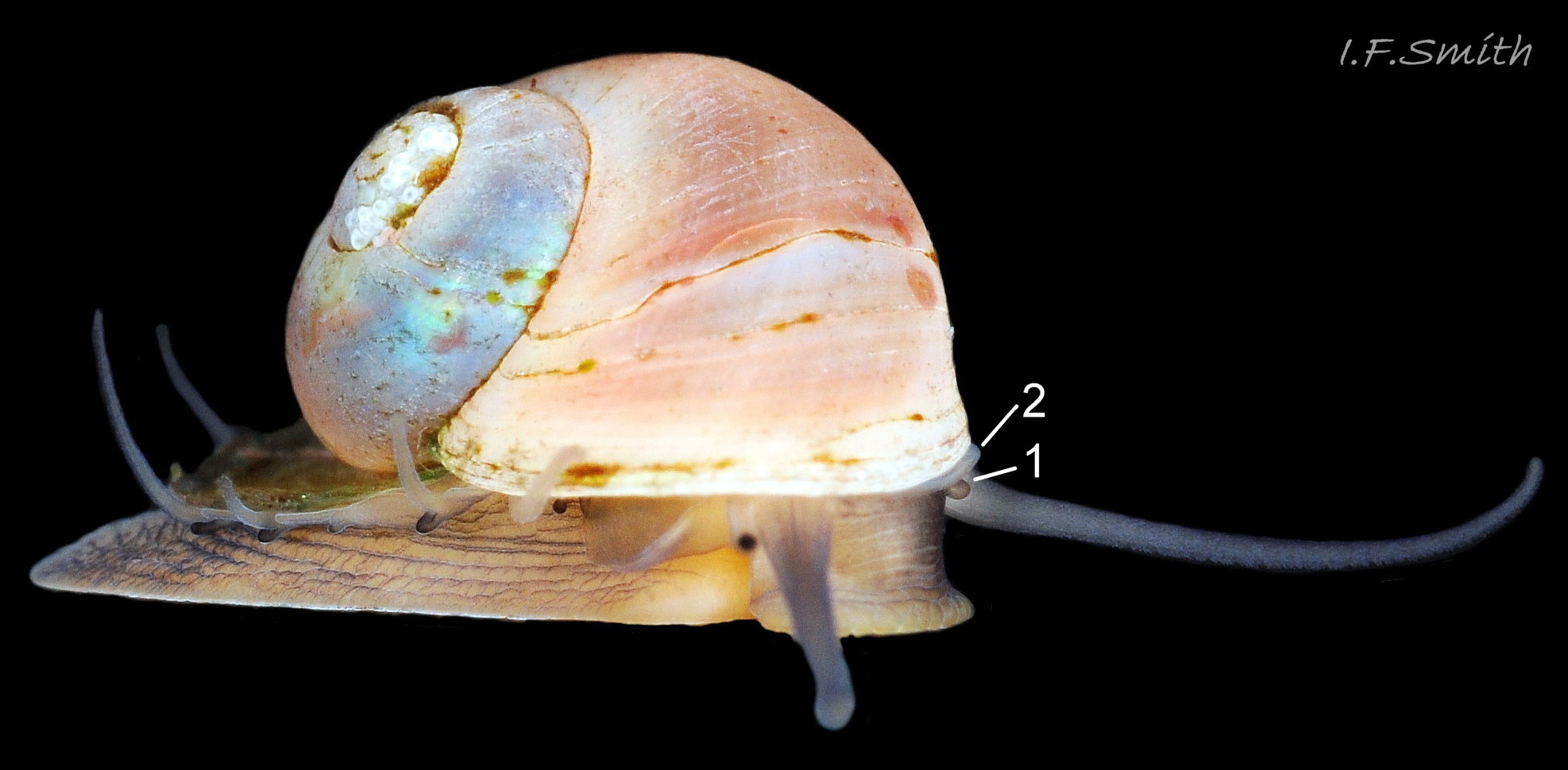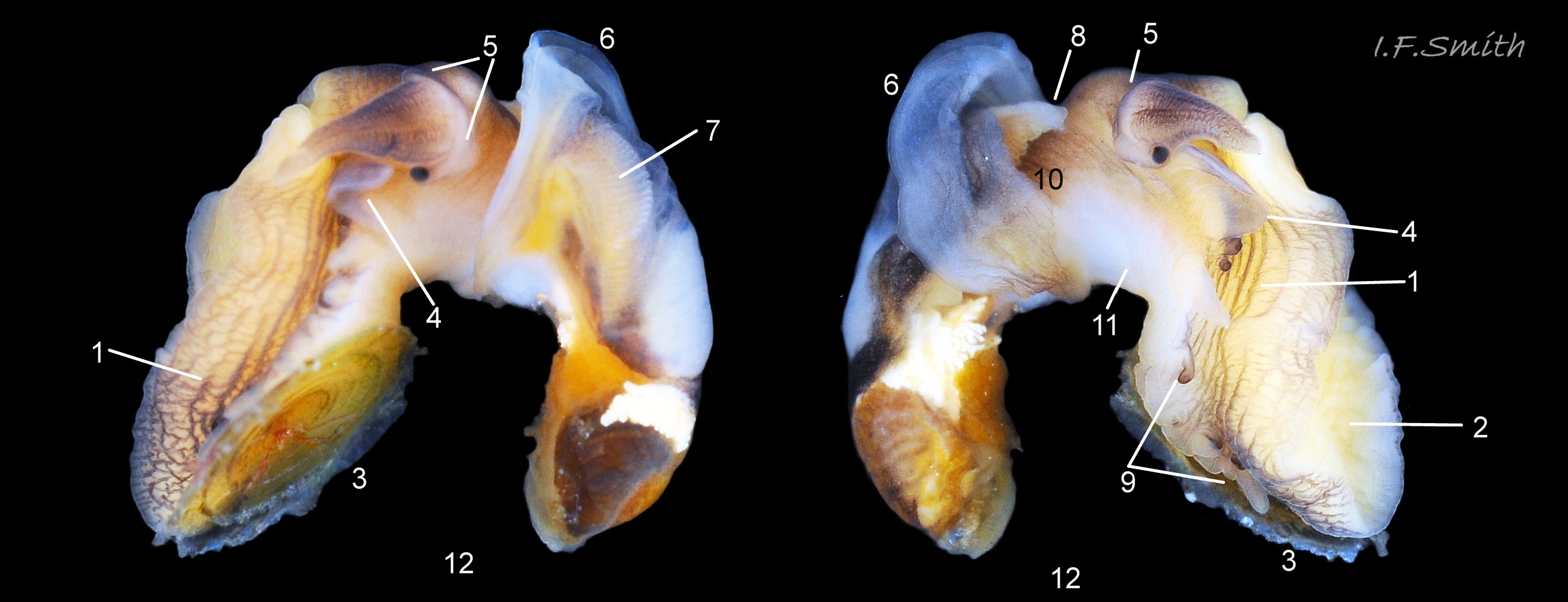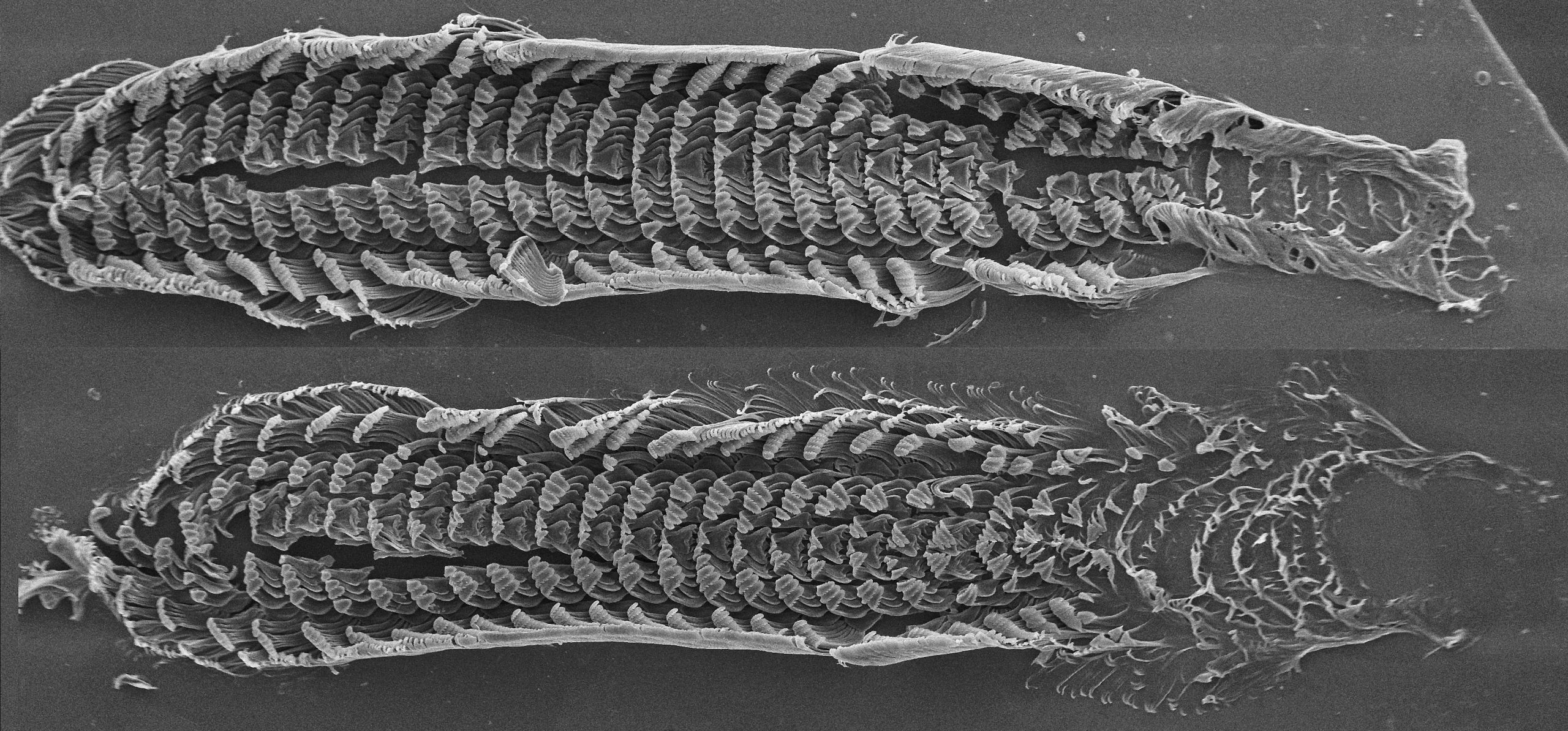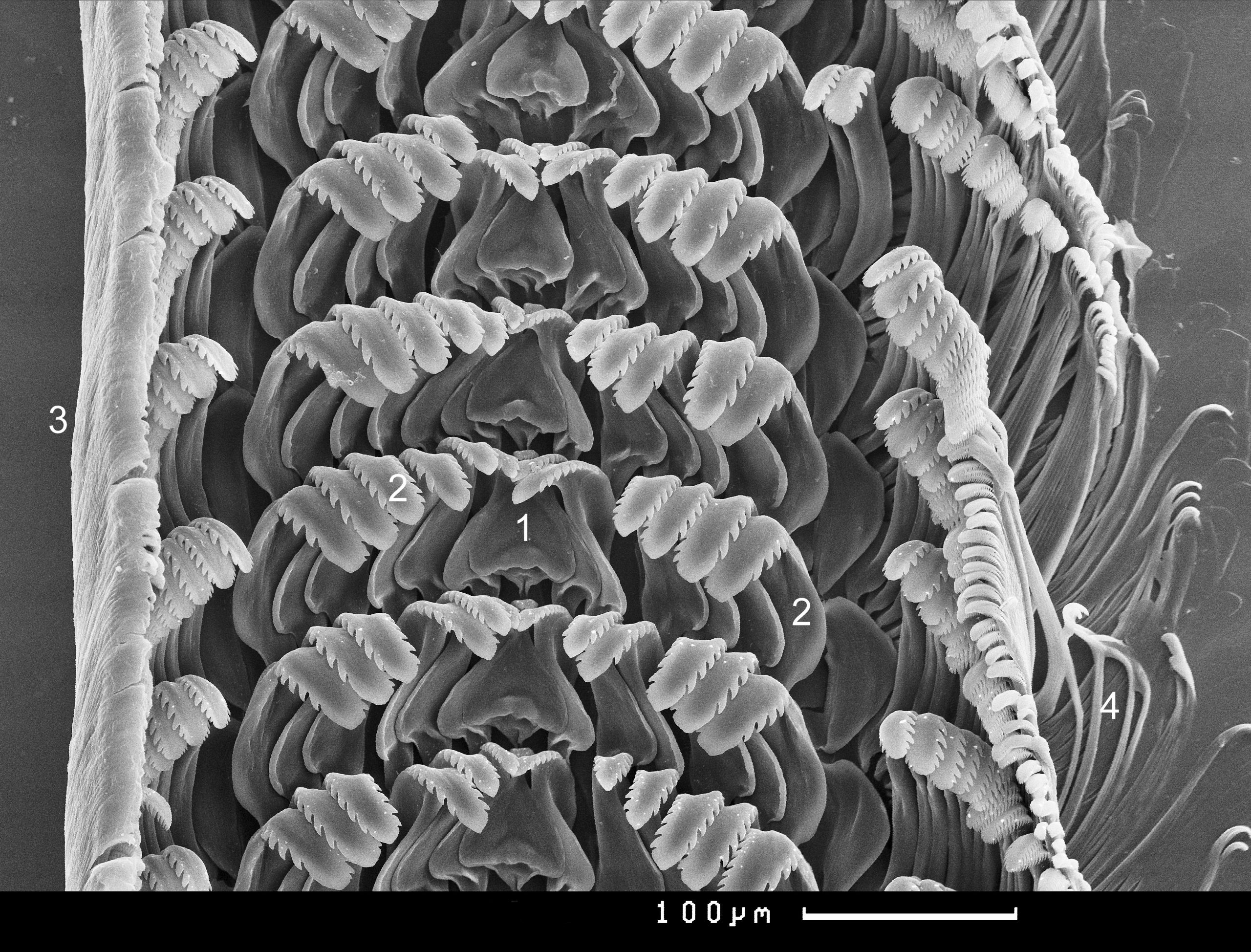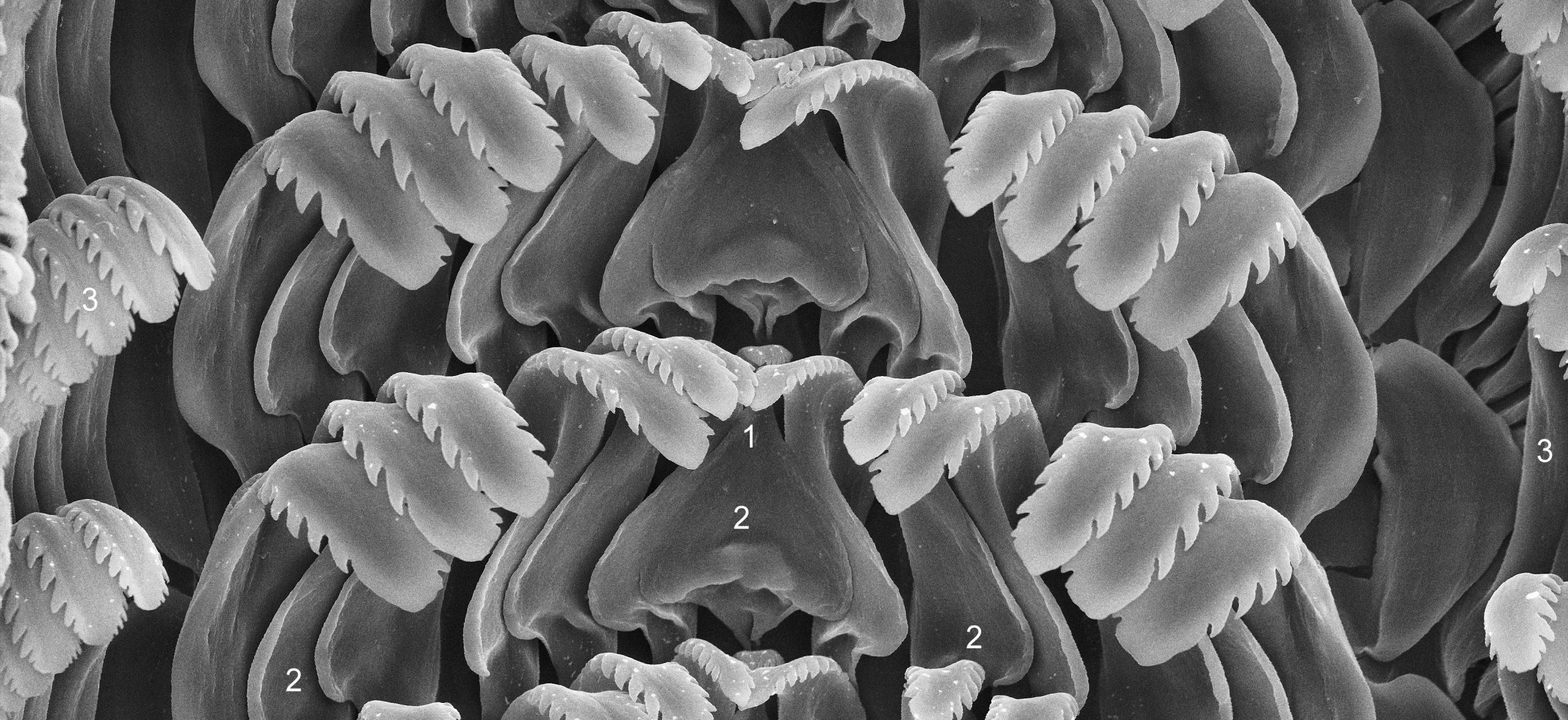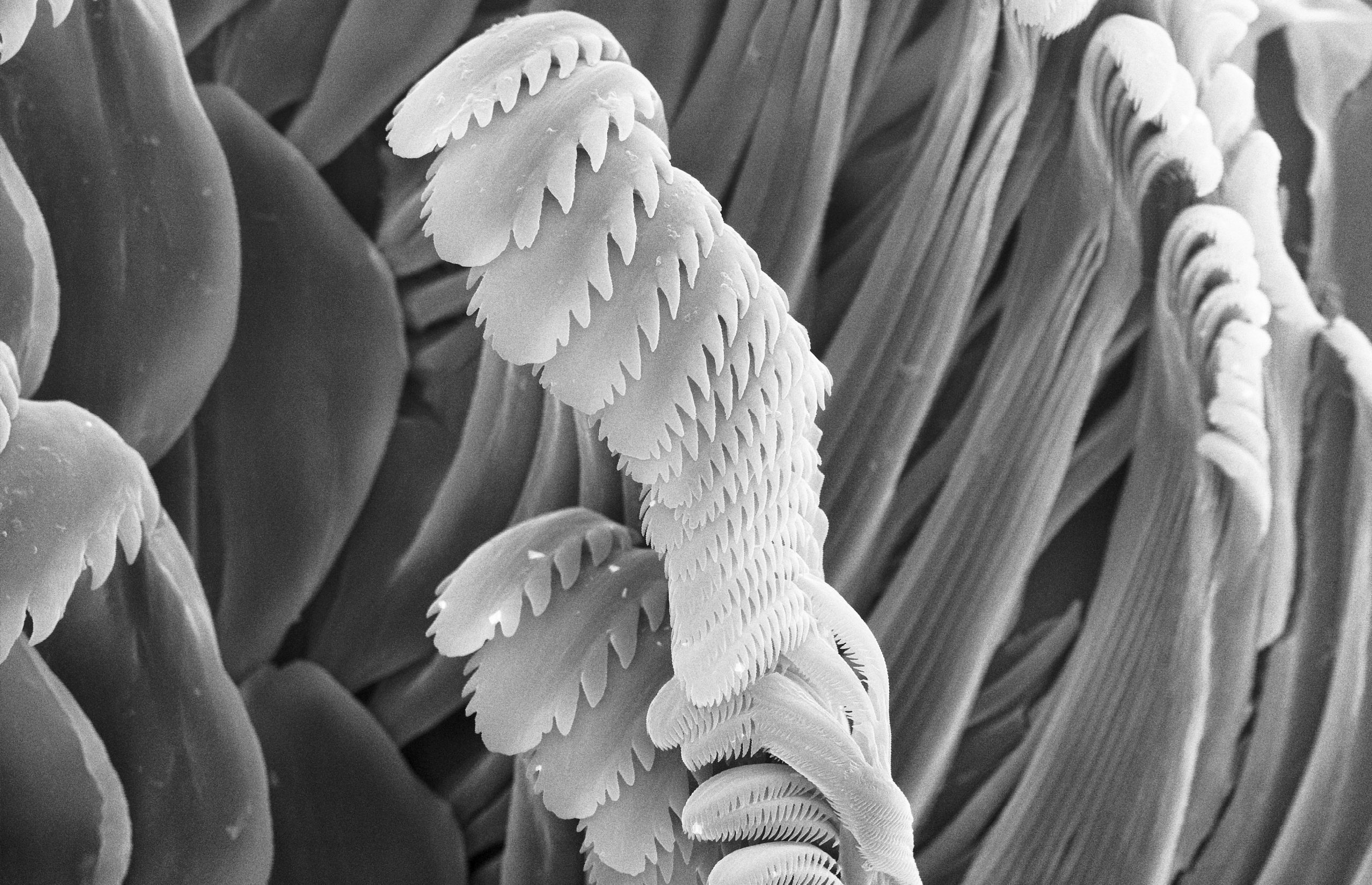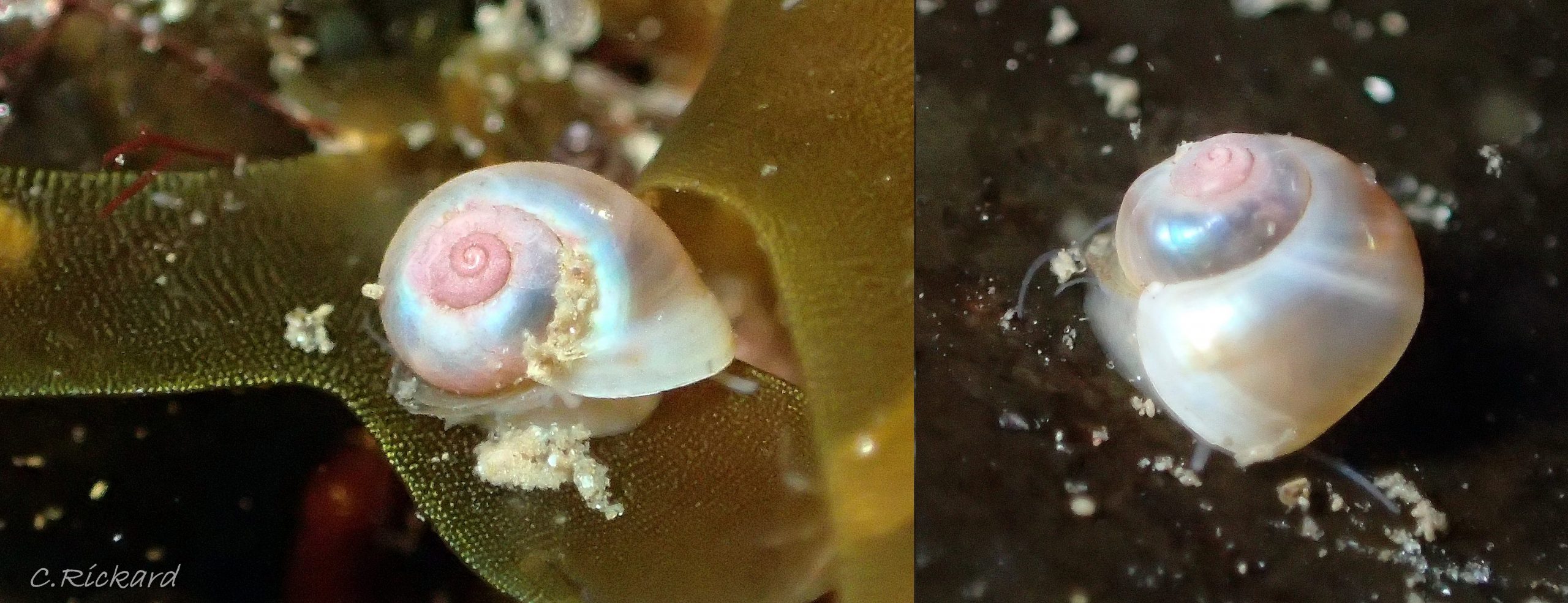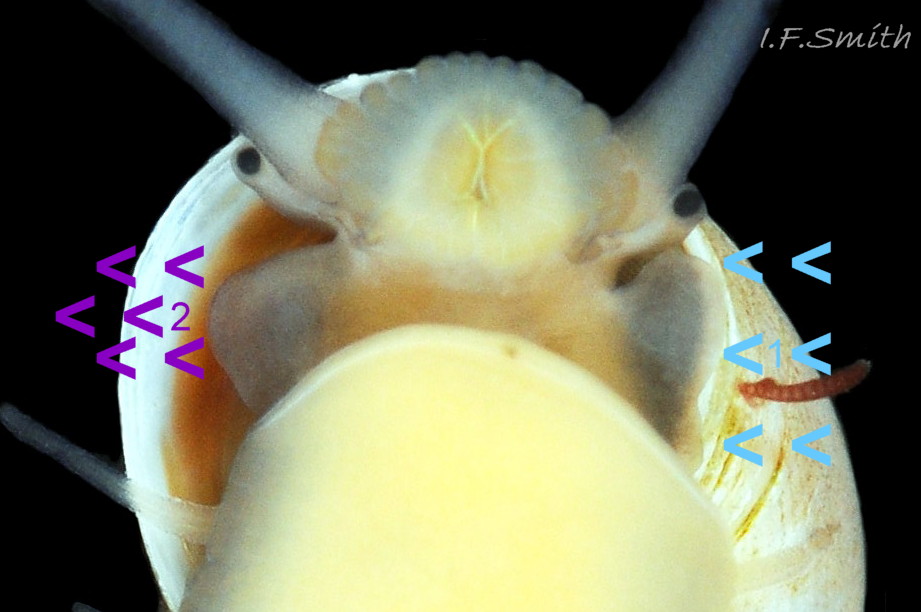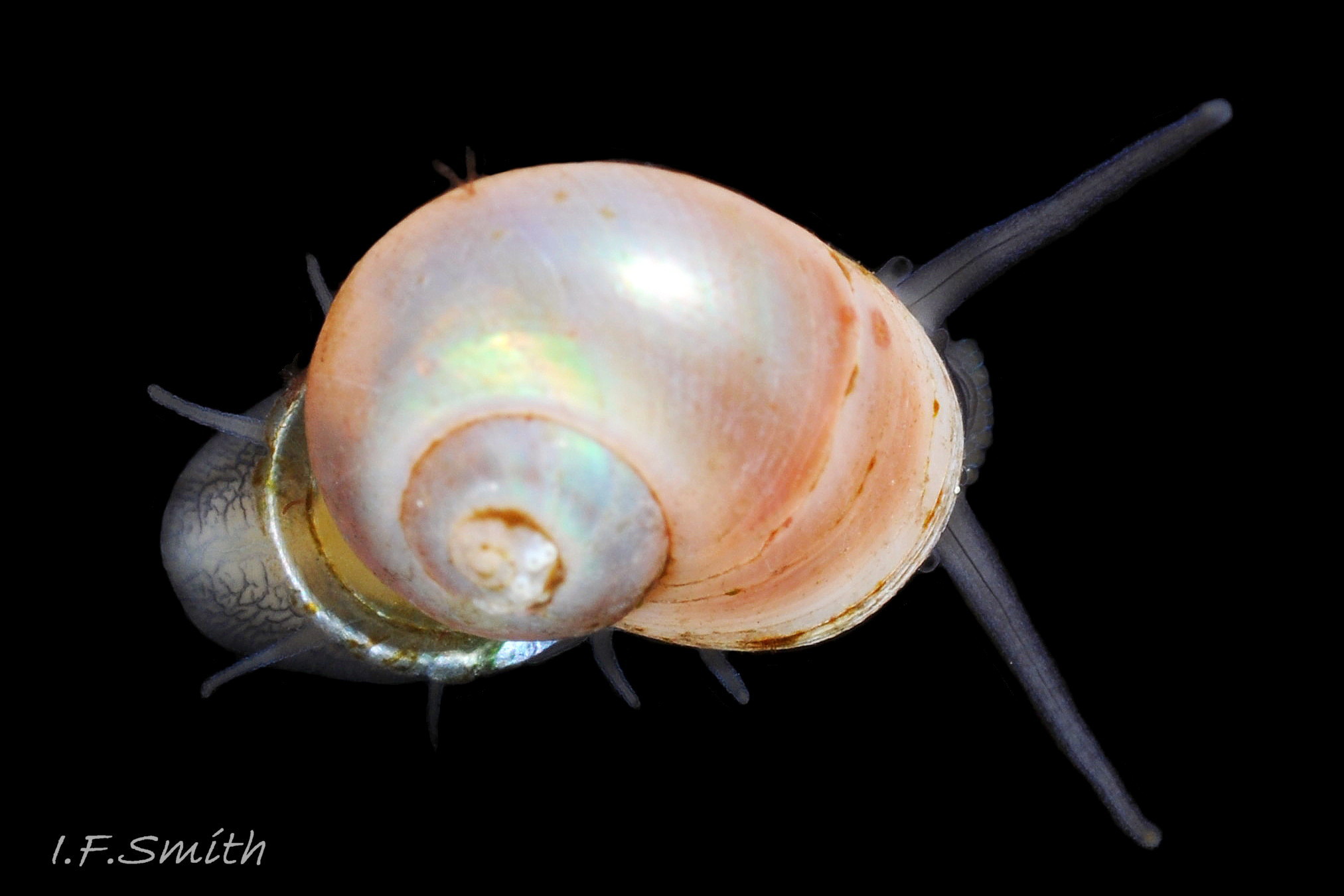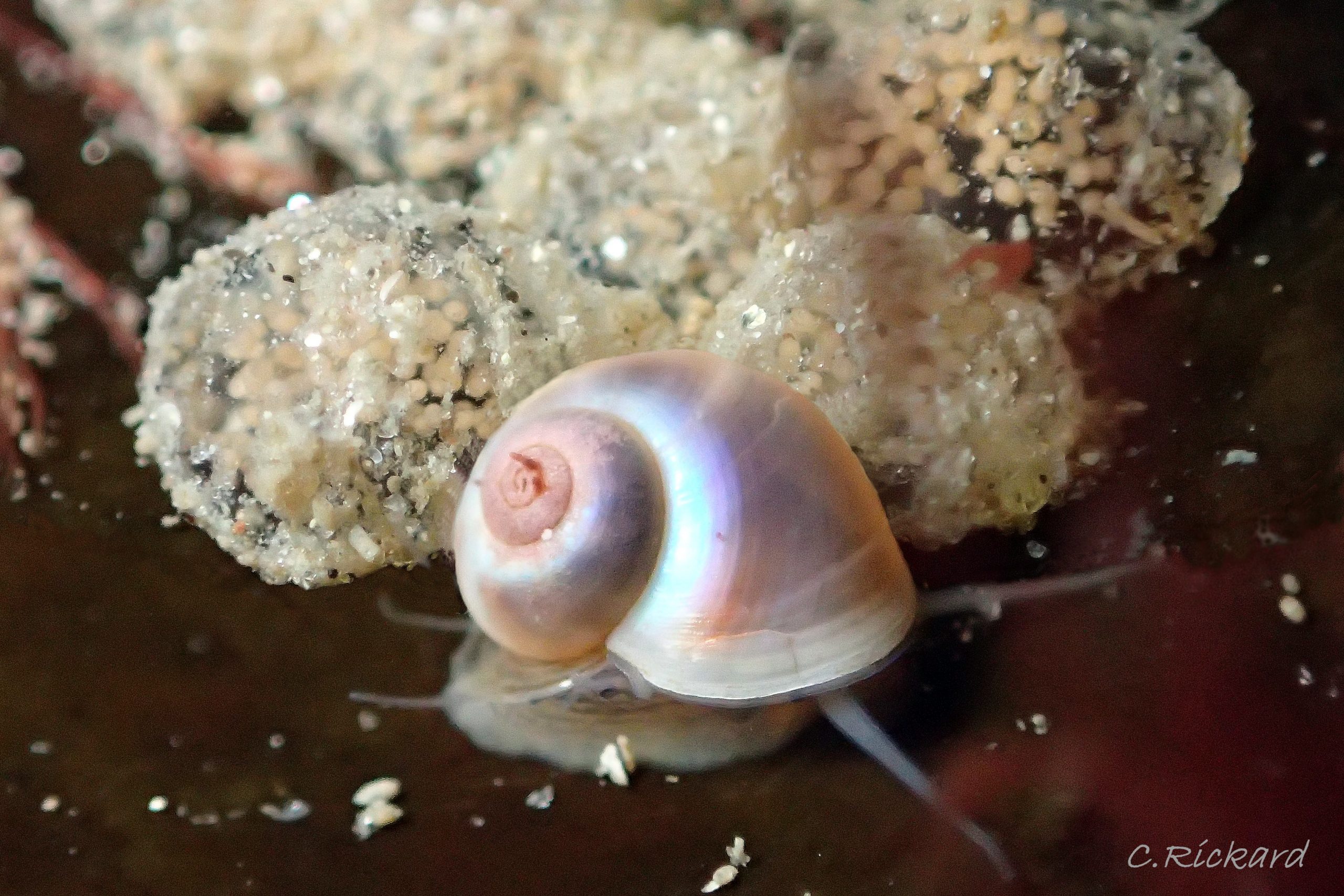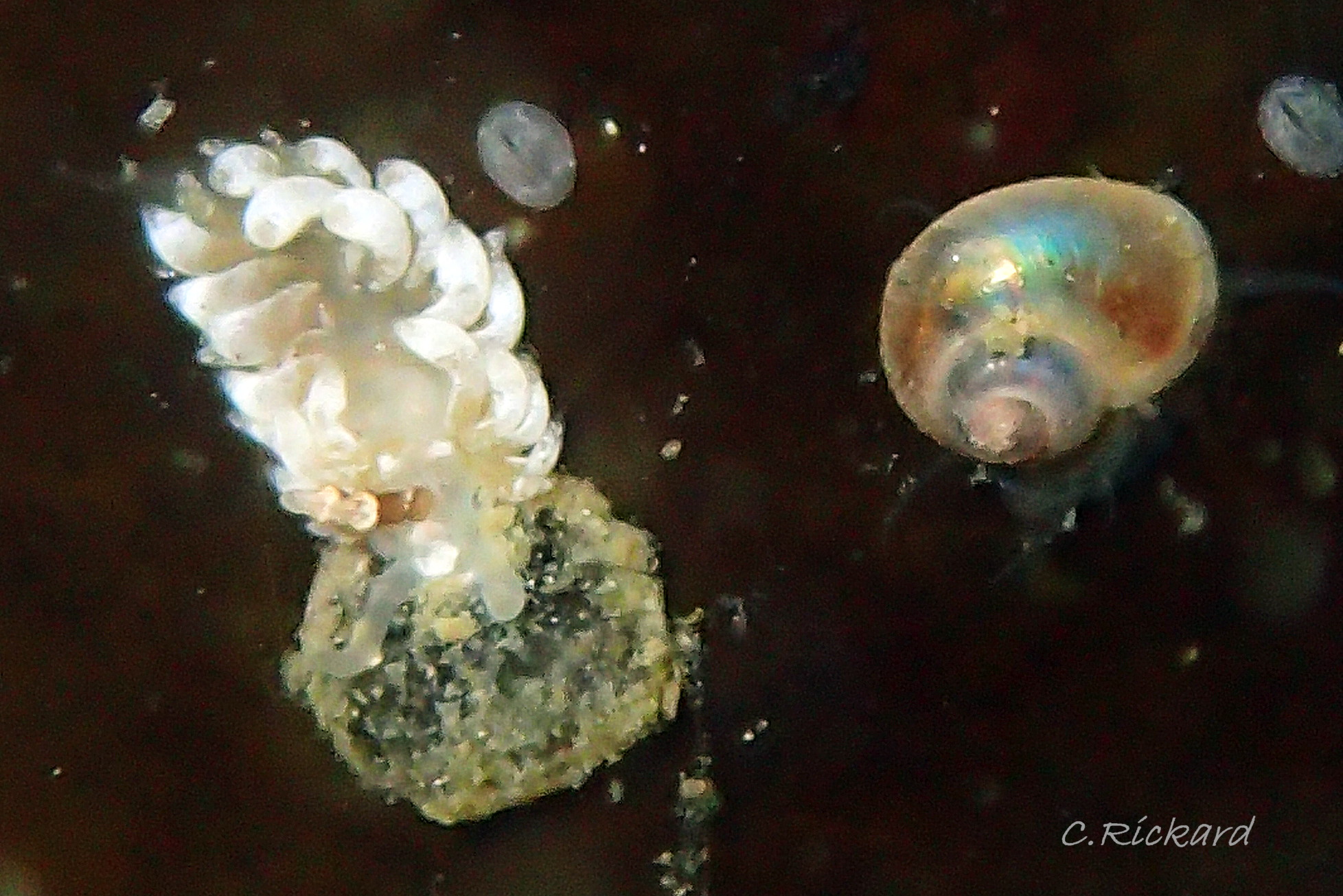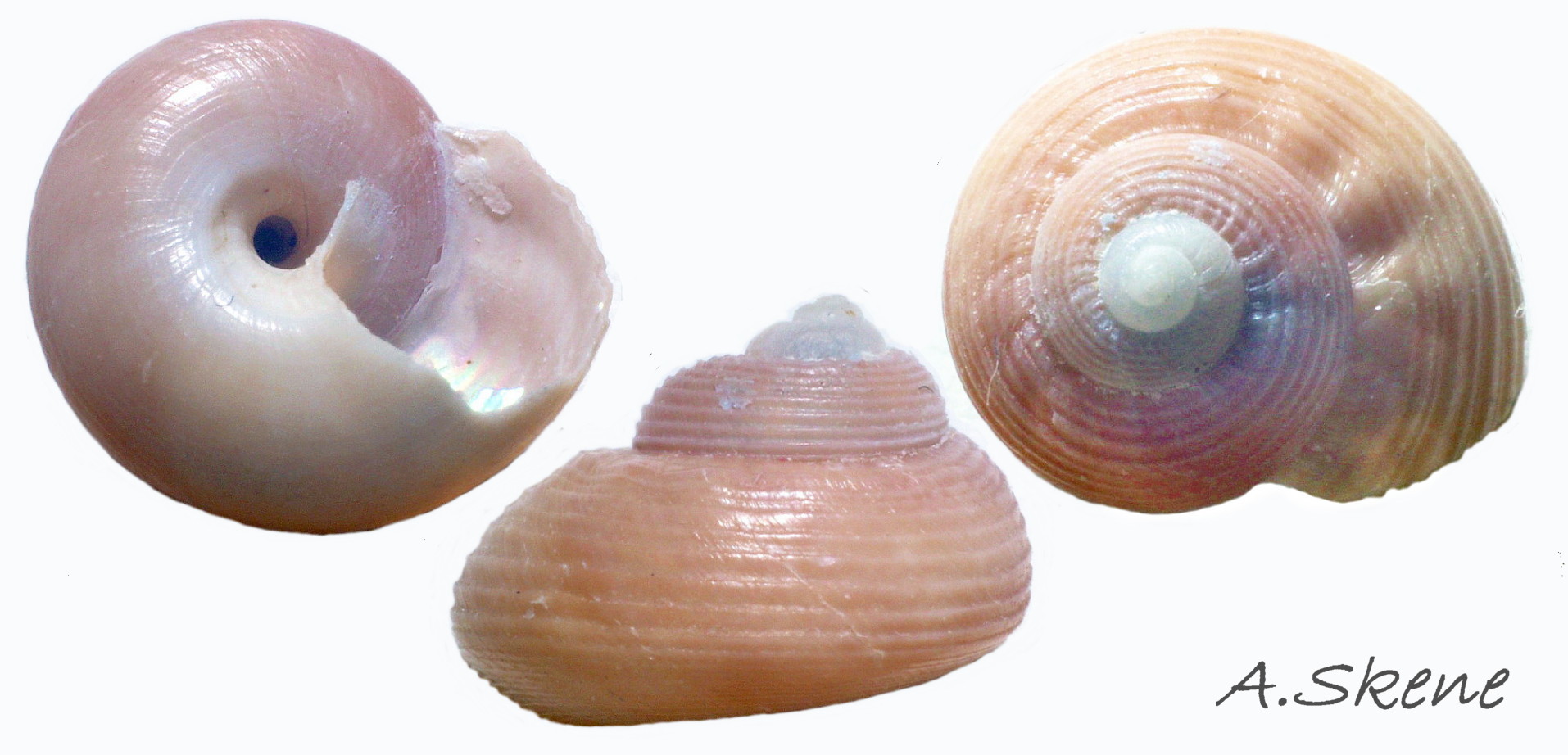Click image to enlarge with full caption. Main text below slider.
Margarites helicinus (Phipps, 1774)
PDF available at www.researchgate.net/publication/346974879_Margarites_hel…
Current taxonomy: World Register of Marine Species (WoRMS)
www.marinespecies.org/aphia.php?p=taxdetails&id=141821
Synonyms: Turbo helicinus Phipps, 1774; Trochus helicinus (Phipps, 1774) [in Jeffreys, and Forbes & Hanley];
Meaning of name: Margarites = [Greek] a pearl . helicinus = [Latin] like a helix.
Vernacular: Pearly top shell (English); Top môr perlaidd (Welsh); Perlesnegl (Danish); Ezoshitadami (Japanese);
GLOSSARY below.
Shell description
Usually, diameter to 6mm, height to 5mm in Britain 01 Margarites helicinus but, in Greenland, up to 11mm diameter and 9mm height. Shell-walls thin and fragile 02 Margarites helicinus Profile depressed-globose; whorls smoothly convex with no angulation. Apical angle varies 85º – 122º (Fretter & Graham, 1977). Height varies, about 80% of diameter . Spire small; body whorl height about 90% of shell height 01 Margarites helicinus Body whorl expands rapidly to expanded outer lip of aperture. Surface smooth; sculpture is restricted to slight spiral striae on the base, and growth lines that are faint except where they run into the umbilicus. 03 Margarites helicinus and, sometimes, a few very faint spiral striae on the body whorl 03 Margarites helicinus. Occasional, irregular, stronger growth lines occur where lip was previously damaged 03 Margarites helicinus. Narrow, deep, oval umbilicus 02 Margarites helicinus. . Aperture almost circular, large; occupies about 50% of the base 03 Margarites helicinus. Thin, curved, palatal (outer) lip tapers to a fine edge, but thickens where it joins the columellar lip, which is narrow, curved, and folds back only slightly at the umbilicus 01 Margarites helicinus. A distinct, parietal lip is reflected onto the body whorl. Adapical angle of aperture is about 90º .
The external ground colour of the shell is horny to orange red 03 Margarites helicinus, and some have one or two variably defined, brownish, spiral bands 05 Margarites helicinus. There are often areas of green or purple iridescence, especially when wet and periostracum intact, and the thinness of the translucent shell enables the more completely iridescent, interior nacre to shine through to give the whole shell a bronze-like lustre. Translucence also allows the body within to affect the external colour of live specimens 06 Margarites helicinus. Internally, the shell is coated with iridescent nacre 02 Margarites helicinus which also transmits the horn/orange of the underlying layer. The transparent, horn coloured, circular, spiral operculum has about 12 narrow coils and a central concavity externally and a small central boss internally 03 Margarites helicinus. On live specimens, the pale opercular disc and grey reticulation of the foot-dorsum are usually visible through the operculum.
Body description
Ground colour of dorsal surfaces of head-foot yellow/orange; overlaid with network of purple-grey, and the mantle is translucent white 07 Margarites helicinus. Stout snout ends in slightly expanded, circular yellow-white tip with a vertical slit mouth and crenate outer lips 08 Margarites helicinus. Snout extends to form lateral ridges 08 Margarites helicinus that can expand into flaps 09 Margarites helicinus. Ventral surface of snout is yellow-white 08 Margarites helicinus and the dorsal surface is purple-grey with vertical and horizontal creases 09 Margarites helicinus & 10 Margarites helicinus. The cephalic tentacles are long and purple-grey with a dorsal groove and many fine annular, and other, creases roughening the surface 09 Margarites helicinus, most pronouncedly when the tentacles are contracted 11 Margarites helicinus. A large black eye is set into the slightly expanded, truncated end of an eye-tentacle that is fused for its entire length to the distal face and ventral base of each cephalic tentacle 11 Margarites helicinus. At the base of each tentacle’s proximal face there is a small smooth-edged cephalic lappet 07 Margarites helicinus & 12 Margarites helicinus. Behind each eye-tentacle there is a large, smooth-edged, translucent, distally purple-grey neck-lobe 08 Margarites helicinus that is usually curved into a half siphon 09 Margarites helicinus for inhalant water on the left of the animal, and for exhalent water, faeces and reproductive products on the right. The yellow-orange dorsal surface of the foot has about six major longitudinal creases on each side with many lesser, connecting, transverse creases, all coloured purple-grey 12 Margarites helicinus; creases are absent from anterior of the foot and from a medial band on its posterior 10 Margarites helicinus.. The epipodium is a ridge along each side of the foot bearing five to seven epipodial tentacles of varying size, each with a black sensory papilla resembling an eye at its base 09 Margarites helicinus; sometimes there are some papillae without an associated tentacle. Part of the epipodium passes under the operculum, where it terminates 10 Margarites helicinus, unless the white medial area on the posterior of the foot is its continuation. The epipodial tentacles are colourless translucent with, like the cephalic tentacles, many fine annular creases and other creases roughening the surface 09 Margarites helicinus. The opercular disc does not enclose any of the operculum edge; it is visible as pale patch through the translucent operculum when the animal is retracted into its shell 03 Margarites helicinus. The anterior of the sole is bluntly curved, and the posterior is similar or bluntly pointed. Colour varies yellow to white, depending on degree of compression/extension, anterior edge bilaminate 13 Margarites helicinus. Fertilization is external, so there is no penis on males.
Internal features
Features on a specimen extracted from its shell are shown on image 14 Margarites helicinus.
The mantle cavity contains a dull-yellow, bipectinate ctenidium with substantial leaflets 15 Margarites helicinus . A large urogenital papilla occupies the rear right of the mantle cavity on females, but is much smaller on males.
The broad radula 16 Margarites helicinus is of rhipodoglossan form, probably the most primitive type of gastropod radula (Fretter & Graham, 1962). In each row of teeth 17 Margarites helicinus , the central rachidian is flanked on each side by six laterals with wide cusped stems 18 Margarites helicinus , followed by numerous long bristle-like marginals 19 Margarites helicinus. The teeth have spatulate tips with pectinate edges suited to sweeping rather than cutting or scraping. Often the rachidian and laterals are worn away from the operative anterior rows, leaving just the long marginals to sweep.
Key identification features
Margarites helicinus
1) Usual maximum diameter 6 mm in Britain.
2) Smooth, depressed globose shell 01 Margarites helicinus.
3) Large, oval umbilicus 02 Margarites helicinus , no longitudinal slit or ‘chink’.
4) Horny to orange-red shell, sometimes brown, especially juveniles, often with some green or purple iridescence 03 Margarites helicinus & 05 Margarites helicinus.
5) Six (sometimes five or seven) epipodial tentacles with black sensory papillae on each side of body 09 Margarites helicinus & 10 Margarites helicinus .
6) Locally common north of Flamborough Head and Islay, Scotland. A few Irish Sea records as far south as S. Wales. Circumboreal.
Similar species
Lacuna parva (da Costa, 1778) 25 Margarites helicinus
1) Usual maximum height 4 mm, sometimes 6 mm in northern Scotland.
2) Smooth, globose shell, not depressed.
3) Distinct umbilicus at end of a long groove/chink.
4) Some whitish or yellowish brown, no iridescence.
5) No epipodial tentacles, but two metapodial tentacles protrude from below the operculum.
6) All around Britain.
Margarites groenlandicus (Gmelin, 1771) 26 Margarites helicinus album. COMPARISON image of Margarites groenlandicus. Orkney, Scotland. © A. Skene.
1) Usual maximum diameter 5 mm in Britain.
2) Spirally ribbed, depressed, globose shell.
3) Distinct umbilicus, no longitudinal slit or ‘chink’.
4) Shell cream, orange or pink. No external iridescence, but blue-green refraction in aperture.
5) Seven epipodial tentacles with black sensory papillae on each side of body
6) Rare, LWS to -75m, far north coast of Scotland, Orkney, Shetland. More frequent in Norway. Atlantic America Arctic to Cape Cod.
Habits and ecology
On lower shore to a few metres depth, gregarious on Laminaria, Fucus and small red algae 20 Margarites helicinus and, more frequently, under stones; not on top when emersed. To 400m depth in Greenland.
Respiration: cilia on the dorsal surface of the left neck-lobe beat to create an inhalant current 21 Margarites helicinus to the large bipectinate ctenidium 15 Margarites helicinus. within the mantle cavity 14 Margarites helicinus. Cilia on the dorsal surface of the right neck-lobe create an exhalant current for respiratory water, ova or sperm, and faeces. Feeds by sweeping microphytes (diatoms etc) and detritus from the substrate with its widely fanned rhipidoglossan radula, ‘rhipidos’ (Greek) = fan, with a ‘whirlpool motion’ (Gwatkin, 1914) 16 Margarites helicinus & 17 Margarites helicinus. The closely packed, numerous, bristle-like marginal teeth 19 Margarites helicinus act as a brush and as a sieve to retain fine particles of food and let water escape. The central rachidian and lateral teeth with broad scooped stems 18 Margarites helicinus act as a conveyor belt to carry the gathered food to the oesophagus. M. helicinus is often common on the fronds of Laminaria, for example in Orkney, but unlike the specialist feeders Patella pellucida and Lacuna vincta, it does not consume it, but uses it, and other broad fronded algae and level rock surfaces, as suitable platforms for sweeping. Faeces are rods with a longitudinal groove. Defence: M. helicinus is a very active species. Exposed parts 22 Margarites helicinus may be the posterior of the foot, the operculum, the epipodial tentacles in constant movement to detect approaching threats, and the cephalic tentacles ‘used as a blind man uses a stick’ (Fretter & Graham, 1977). Those with brown shells 05 Margarites helicinus, predominantly juveniles, match in colour the frequently occupied brown algae, and it is perhaps more than coincidence that another habitual utilizer of Laminaria, Patella pellucida, also exhibits iridescence and, presumably, benefits from it in some way, perhaps by distraction or resembling iridescent algae. Its spawn is consumed by the oophagous nudibranch Favorinus branchialis 24 Margarites helicinus which usually preys on spawn of other nudibranchs. The species breeds in spring (Northumberland, England and Isle of Man). Fertilization is external. Females lay about 100 ova, each of which has a gelatinous coat, and all are embedded in a mucous mass secreted by a gland in the large urogenital papilla at the right rear of the mantle cavity 14 Margarites helicinus. The mass, about the size of the parent after the ova have absorbed water and expanded 23 Margarites helicinus, is attached to algae or the underside of stones by anchoring protrusions of the mass moulded by the female’s foot. Frequently, several masses will be found together as the species tends to live gregariously. The trochophore and veliger stages are passed within the ova, and crawling, usually brown-shelled, young emerge to join the adults on rock or alga (photo J. Batten) flic.kr/p/67UC7w . The lifespan is slightly more than a year.
Distribution and status
Circumboreal, north Greenland to Massachusetts; Alaska to Vancouver Island and northern Japan; Svalbard to Britain; not Denmark or southern North Sea or inner Baltic. GBIF map www.gbif.org/species/9716348 . In Britain, locally common north of Flamborough Head and Islay, Scotland. A few records from N. Ireland, Isle of Man and S. Wales. U.K. map NBN species.nbnatlas.org/species/NBNSYS0000176373
.
Acknowledgements
This species account would not have been possible without the live specimen brought to me for photography by Simon Taylor, the SEM images of radulae provided by Ivan Nekhaev and the images of specimens and spawn provided by Chris Rickard and Alastair Skene. I am most grateful for their generous help.
Links and references
Forbes, E. & Hanley S. 1849-53. A history of the British mollusca and their shells. vol. 2 (1849), London, van Voorst. (As Trochus helicinus); Free pdf at archive.org/stream/historyofbritish02forb#page/530/mode/2up Use slide at base of page to select pp.531-534.)
Fretter, V. and Graham, A. 1962. British prosobranch molluscs: their functional anatomy and ecology. Ray Society, London. (Has index of species.)
Fretter, V. and Graham, A. 1977. The prosobranch molluscs of Britain and Denmark. Part 2 – Trochacea. Suppl. 3, J. Moll. Stud..
Fretter, V. and Graham, A. 1994. British prosobranch molluscs: their functional anatomy and ecology. Revised edition. Ray Society, London. (Much new material but lacks index of species.)
Graham, A. 1988. Molluscs: prosobranch and pyramidellid gastropods: keys and notes for the identification of the species. Brill & Backhuys, for Linn. Soc. Lond. & Estuarine and Brackish-water Sciences Assoc. Synopses of the British Fauna (New Series) no.2. Edition 2 (662pages). Leiden. (Edition 1 of series, 1971, 112 pages, is no substitute.)
Gwatkin, H.M. 1914. Some molluscan radulae. J. Conch. 14: 139 to 148.
www.biodiversitylibrary.org/item/98719#page/167/mode/1up
Jeffreys, J.G. 1862-69. British conchology. vol. 3 (1865). London, van Voorst. (As Trochus helicinus); Free pdf at archive.org/stream/britishconcholog03jeff#page/294/mode/2up . Use slide at base of page to select pp.295- 298.
Wigham, G.D. & Graham, A. 2017. Marine gastropods 1: Patellogastropoda and Vetigastropoda. Synopses of the British Fauna (New Series) no.60. (172 pages). Field Studies Council. Telford.
www.field-studies-council.org/publications/pubs/marine-ga…
Current taxonomy: World Register of Marine Species (WoRMS)
www.marinespecies.org/aphia.php?p=taxdetails&id=141821
Glossary
adapical = towards the apex of the shell.
aperture = mouth of gastropod shell; outlet for head and foot.
cephalic = (adj.) of or on the head.
cilia = (pl.) vibrating linear extensions of membrane used in feeding or locomotion. (“cilium” singular).
ciliated = (adj.) coated with cilia.
columella = solid or hollow axial “little column” around which gastropod shell spirals; hidden inside shell, except on final whorl next to lower part of inner lip of aperture where hollow ones may end in an umbilicus or siphonal canal.
columellar = (adj.) of or near central axis of spiral gastropod.
columellar lip = lower (abapical) part of inner lip of aperture.
ctenidium = comb-like molluscan gill; usually an axis with a row of filaments either side.
diatom = microscopic aquatic alga with siliceous cell-walls.
ELWS = extreme low water spring tide (usually near March and September equinoxes).
epipodial = (adj.) of the epipodium.
epipodium = collar or circlet running round sides of foot of some gastropods, bearing bosses, lobes and / or tentacles.
height = (of gastropod shells) distance from apex of spire to base of aperture.
mantle = sheet of tissue that secretes the shell and forms a cavity for the gill in most marine molluscs.
microphytes = microscopic, unicellular algae, such as diatoms. (a.k.a. microalgae). Exist individually, or in chains or groups.
oophagous = feeding on eggs.
opercular = (adj.) of the operculum.
opercular disc = part of foot that growing operculum rotates on.
opercular lobe = extension of opercular disc round edge of part of operculum.
operculum = plate of horny conchiolin, rarely calcareous, used to close shell aperture.
papilla = (pl. papillae) small cone-shaped protrusion of flesh.
papillate = covered in papillae
periostracum = thin horny layer of chitinous material often coating shells.
umbilicus = cavity up axis of some gastropods, open as a hole or chink on base of shell, often sealed over.
trochophore = spherical or pear-shaped larvae that swim with aid of girdle of cilia. Stage preceding veliger, passed within gastropod egg in most spp.
veliger = shelled larva of marine gastropod or bivalve mollusc which swims by beating cilia of a velum (bilobed flap). Passed within ova of M. helicinus
